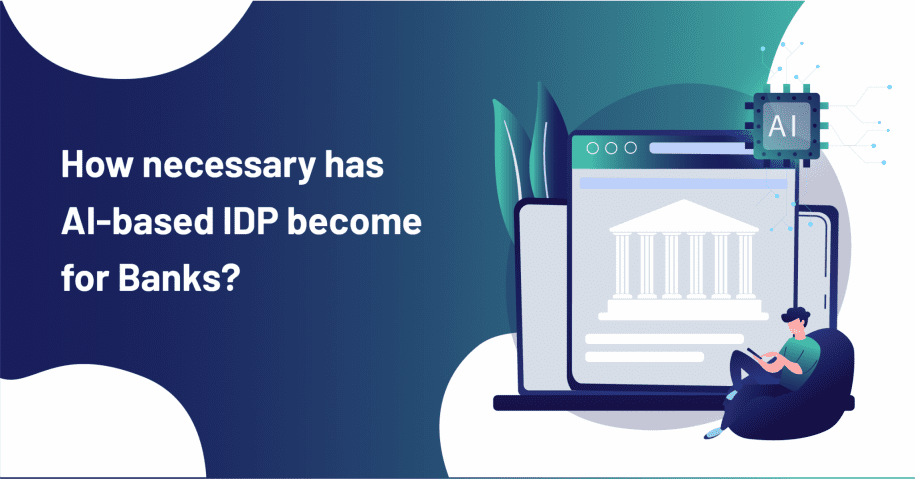Intelligent Document Processing (IDP) is an AI-based technology that retrieves big data and uses machine learning to process and improve it with less human intervention. It is different from traditional stand-alone Optical Character Recognition (OCR) solutions, wherein it uses AI to combine robotic process automation with OCR. It can be challenging for traditional technology to process a mortgage package containing up to 20 different forms, like W2 forms, bank statements and certificates of information.
With the combination of NLP – Natural Language Processing and OCR, you can extract data and automate these documents, use Artificial Intelligence (AI) to segment and categorise the documents, solve the limitations you face and save time.
The Challenges Related to Document Processing in Banks
Documents like online forms, images, signatures, blueprints, PDFs, etc., are the most important part of the banking system and significantly impact day-to-day operations. Besides documentation, other day-to-day challenges include account opening, closure of accounts, credit application, etc.
Banks can employ manual intelligence using IDP to carry out these tasks, automatically extract data, and finally, feed them to the existing portal/system while maintaining consistency in various tasks.
IDP Relevance and Functioning
Today, banks are gradually using IDP to replace the old, time-consuming methods used in mortgage processing and provide customers with a quick banking experience.
People normally complain about the unreasonable time taken by banks to process documents in various bank-related functions. Intelligent document processing is a thriving AI technology that processes data by gauging particular data points in context and turning unstructured data into actionable insights, rather than relying on location within each banking document.
How Important is IDP in Banking?
- IDP ensures that you don’t have to extract and save machine-generated text or scanned documents from other sources.
- IDP helps to free knowledge workers who had to manually and immediately process bank forms. This is especially true where employees were required to indulge in continuous management and auditing of several documents to maintain the quality of their work.
- IDP ensures compliance in the banking and finance sector. Advances in digital transformations have opened up new opportunities for banks to store banking documents more efficiently.
Where Does the Banking Industry Use IDP?
Big data opens new avenues for revenue generation for both consumers and banks. Bank executives recognise that extracting data and using it offers significant competitive advantages.
The banking and finance industry is leading in digital transformations, prioritizing Intelligent Document Processing (IDP) in the following:
1. Analysing big data
The loan application alone produces a large amount of data to run the backend process. However, this data is not always in an accessible format. Also, its integrity is not checked. Automatically interpreting customer documents using IDP generates useful insights for banks and solves their problems.
Banks can apply intelligent automation technology to enhance validation and auto-populate existing applications. Advanced analytics enable real-time reporting and insights from multiple sources, enabling organisations to leverage, analyse and execute insights to inform bank value propositions.
2. Sorting the financial consequences of the COVID effect
The digital solution was developed overnight to meet the customer’s needs for security and convenience, making cashless payments second nature. Banks had quick answers, and customers could communicate with banks through bankers.
Digital lending solutions are always subject to strict compliance obligations. Banks naturally have great opportunities to improve their ability to achieve regulatory compliance through automated IDP, to enable rapid deployment and realization of benefits.
3. Improving overall efficiency
Employing IDP in banking means lowering the cost-income ratio, reducing loan processing time, ensuring compliance and processing information more accurately without manual intervention. The goal is to achieve greater speed, accuracy, reliability and scalability.
4. Restructuring open banking
If a bank wants to offer a better financial product, it needs to be data-driven. Introducing IDP in banking ensures adequate service to meet customer needs and expectations and improves the productivity and efficiency of the entire organisation while reducing operational risk.
How Can IDP Help in Bank Automation?
The advanced software will digitise what you need, route important data and improve customer experience. By automating the identification of documents, IDP helps streamline the key components of KYC compliance and reduces the workload of their staff. End-to-end automation of document processing makes it easier for banks to reach their business goals. IDP helps improve back-office staff’s efficiency and overall satisfaction.
1. Bank forms processing
Banks are incessantly handling increased withdrawals from retirement accounts, loan applications and so much more. Paper-based handling is time-consuming, error-prone and requires more human effort. IDPs can convert bank forms into digitally accessible documents in seconds. It converts all data, pure text format or table/graphics, into machine-readable data and processes it, making employees’ jobs much easier.
2. Credit application processing
Loan application processing requires intensive and time-consuming extraction of document data. Automatic processing of application forms using IDP improves data output accuracy and speeds up equipment processing.
3. Mortgage document processing
The mortgage process is when a customer or a company requires a significant amount of credit which requires documentation like tax refunds, payslips, ID proofs, bank statements, purchase documents, profit and loss accounts, balance sheets, cash flow statements, etc.
IDP helps combine these documents to create a large amount of data that needs to be searched, extracted and validated with zero errors.
4. Document processing automation in the following
- Opening an account and account closure – IDP automates account opening, integrating customer data into the core system. Banks use robotic process automation to upgrade and automate account closure through the same system.
- Data extraction from the annual report – IDP helps to automatically capture data from annual reports to create research reports for intelligent decision-making.
- Other Benefits of IDP – It helps process documents after loan termination, generates customer risk profiles and risk assessments through KYC, and allows paper-based data to be sent to fraud detection engines with Artificial Intelligence algorithms. It further helps in processing financial product applications and billing forms for various products to speed up device processing. It increases productivity by 60%.
Final Thought
IDP can revolutionise banking forever. The integration of technology and innovation has eased data management in the finance and banking sector. Traditional methods were becoming increasingly difficult to effectively manage data mismanagement, employee expense fraud, human error compliance violations, etc. By choosing IDP software with Artificial Intelligence, banks can streamline processes and eliminate redundant data.
IDP helps banks automate manual banking forms related to loan formation, loan application, bank account opening and other inquiries to improve the accuracy of data entry/output and customer experience. IDPs provide additional support to employees by ultimately reducing the costs associated with data processing and helping them reach their goals. From a banking / financial sector perspective, the future with IDP is certainly much less stressful.




Leave a Reply